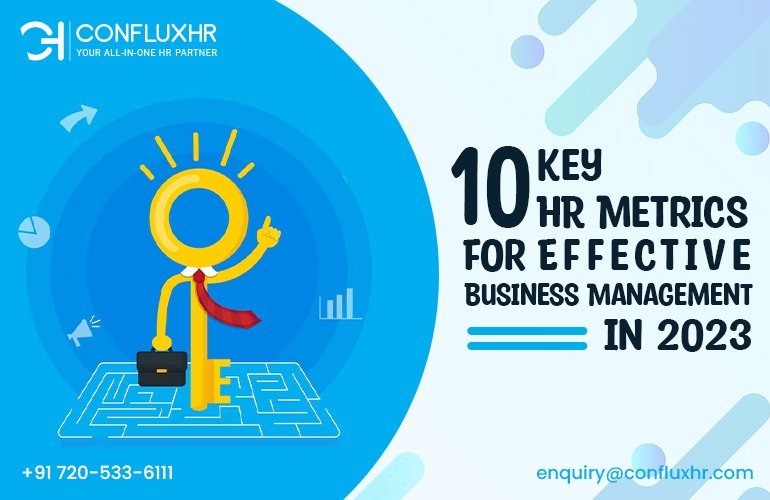In today’s competitive business landscape, effective management of human resources is crucial for the success of any organization. HR metrics play a vital role in providing valuable insights and data-driven decision-making.
By tracking and analyzing key HR metrics, businesses can optimize their workforce, improve employee engagement, and drive overall organizational performance.
In this blog, we will explore the top 10 HR metrics that are essential for effective business management in 2023.
Employee Turnover Rate
Employee turnover rate measures the percentage of employees who leave the organization within a specific period.
Tracking this metric helps identify potential issues, such as high turnover in certain departments or teams, enabling HR to take proactive steps to improve retention and address underlying concerns.
Time-to-Fill
Time-to-fill measures the average time taken to fill open positions within the organization. This metric helps evaluate the efficiency of the recruitment process and identifies bottlenecks that may be causing delays.
By reducing time-to-fill, organizations can minimize productivity gaps and ensure a smooth talent acquisition process.
Employee Productivity
Employee productivity measures the output and efficiency of individual employees or teams. It provides insights into how effectively employees utilize their time and resources to accomplish their tasks.
By monitoring and improving employee productivity, organizations can enhance overall operational efficiency and achieve higher levels of performance.
Absenteeism Rate
The absenteeism rate tracks the frequency and duration of employee absences. High absenteeism can impact productivity, increase the workload on other employees, and affect team morale.
By monitoring this metric, HR can identify patterns, address underlying issues, and implement strategies to reduce absenteeism, ultimately fostering a healthier and more engaged workforce.
Training and Development Investment
This metric assesses the investment made by the organization in employee training and development initiatives. It helps gauge the commitment to employee growth and development, which in turn boosts employee engagement and retention.
By investing in training and development, organizations can enhance employee skills, knowledge, and job satisfaction.
Employee Satisfaction
Employee satisfaction measures the level of contentment and fulfilment employees experience within the organization. A satisfied workforce leads to increased productivity, improved retention, and a positive brand reputation.
By regularly assessing employee satisfaction through surveys or feedback mechanisms, organizations can identify areas for improvement and implement strategies to enhance employee well-being.
Diversity and Inclusion
Diversity and inclusion metrics evaluate the representation and inclusivity of different demographics within the workforce.
By tracking diversity and inclusion metrics, organizations can ensure equal opportunities, foster a culture of inclusivity, and leverage the benefits of diverse perspectives and experiences.
Cost per Hire
Cost per hire calculates the expenses incurred during the recruitment and onboarding process for a new employee.
By monitoring this metric, organizations can assess the effectiveness of their recruitment strategies, identify cost-saving opportunities, and optimize their hiring processes.
Revenue per Employee
Revenue per employee measures the revenue generated by each employee within the organization.
It helps evaluate the overall productivity and efficiency of the workforce. By focusing on increasing revenue per employee, organizations can maximize their resources and improve financial performance.
Employee Engagement
Employee engagement measures the level of emotional commitment and connection employees have with their work and the organization. Engaged employees are more productive, innovative, and likely to stay with the organization.
By monitoring employee engagement through surveys or feedback, organizations can identify areas for improvement and implement initiatives to enhance employee satisfaction and loyalty.
Conclusion
In the dynamic business landscape of 2023, HR metrics provide valuable insights for effective business management. Organizations can make informed decisions, optimize their workforce, and drive success, by tracking and analyzing key HR metrics such as:
- Employee turnover rate
- Time-to-fill
- Employee productivity
- Absenteeism rate
- Training and development investment
- Employee satisfaction
- Diversity and inclusion
- Cost per hire
- Revenue per employee
- Employee engagement
With ConfluxHR, an innovative HR software solution, businesses can easily track and measure these essential metrics, gaining deeper visibility into their HR performance.
Embracing a data-driven approach with ConfluxHR empowers businesses to create a positive work environment, foster employee growth, and achieve sustainable business growth in the years ahead.
Harness the power of ConfluxHR and unlock the full potential of your HR management.



